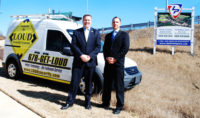

Herb Farnsworth
SDM: Who are your typical customers?
Farnsworth:Our customers are typically larger commercial end users. The guys who started this company all had experience in access control, CCTV, fire alarm, and sound and video. We sell to the user and do a lot of upgrades and change-outs. We participate in the portions of the construction, competitive-bid economy that make sense to us on a limited basis.
SDM: Is that because of margin issues?
Farnsworth:Obviously, we try to maintain reasonable margins, but our primary concern is control. We prefer to control the schedule, quality of work and manpower to deliver customer satisfaction. As an example, we’re not so compressed trying to meet someone else’s schedule that we have to throw in a bunch of overtime at the end.
SDM: How do customers find you?
Farnsworth:A lot of customers have had service and support issues that they come to us to solve. These people have higher technology needs, and our people, training and experience are in higher-end systems. Also because we are so focused on larger users in our local market, we know who they are. We do some phone and direct mailings, but not a lot.
SDM: What percentage of your work involves integrated systems where intrusion protection and/or video and access control function as a single seamless system?
Farnsworth: You have to distinguish between interfacing and integrating. Interfacing means that you take some relay outputs of one system and make those input points to another system. True integration requires software communication between two different products or a common platform (i.e. access and video). Interfacing is probably a half of our business and true integration is only about 25 percent. Everybody is interested in it, but in this market it hasn’t been done a lot.
In a lot of cases, people buy different systems from different vendors — security from one vendor and CCTV from somebody else. Typically, these systems aren’t designed to be compatible and to be integrated. Most manufacturers are wary of who they would give their software documentation to because they want to retain the proprietary nature of their product.
Being proprietary isn’t all bad, because then you know who’s responsible legally for the operation of the system. It’s a matter of people getting comfortable with using one supplier for multiple things. People are beginning to see the value in upgrading their systems. But they need to get the budget funding, and they need to be comfortable with the success they’ll have at the end of the line.
SDM: Do you think the Kansas City market is typical of the U.S. as a whole when it comes to these kinds of issues?
Farnsworth:Typically, the cutting-edge technology and money to fund it happens on the coasts and drifts this way. But Kansas City has many types of companies, including a technology base that includes Sprint and others. I think this market is typical and also that it’s developing. We just completed a large instructional technology center project for Johnson County Community College. They obviously believe in a growing technology need.
SDM: What new technologies are customers asking about today?
Farnsworth:The big buzzword is mass notification, based on problems that have happened at schools, colleges, industrial and government facilities. People want notification on e-mail, PDAs and cell phones that there’s an emergency on campus and they should stay away. That’s great, but it doesn’t solve the problem that there’s someone doing something bad in the building, and people outside don’t have any idea what’s going on inside. True integration of burglar, access, video, intercom and fire alarm can begin to provide that kind of information to on-site police and security departments via broadband wireless connections.




